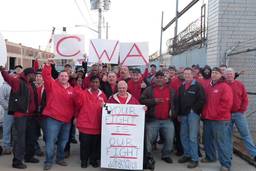The Koch Brothers no longer are interested in buying the Los Angeles Times and its parent company, the Tribune Company. Their dropping of their bid is a victory for unions that fought it, concerned that the Koch’s anti-labor stance would inform Tribune-owned papers from the Chicago Tribune to the Baltimore Sun. From the AFL-CIO Now Blog:
For months, the California Labor Federation, media watchdogs and progressive groups have raised serious concerns about the effect of handing control of major news outlets over to the Kochs. The Kochs’ interest in the Tribune Co. was no doubt fueled by a desire to further their anti-worker, anti-environment agenda by using those media outlets as a megaphone for their extreme ideas.
A new study shows that employed workers are twice as likely to get on a kidney transplant list than unemployed workers — regardless of whether the unemployed workers have insurance. From the National Journal:
In a survey of 429,409 patients with end-stage renal disease, those who had jobs were 2.24 times more likely to be placed on a waiting list for a kidney transplant. Once placed on a list, the employed full-time were 1.65 times more likely to receive the transplant. And having insurance didn’t help the unemployed in this case either. When the researchers ran the numbers on those unemployed who had insurance, they found “the results to be essentially the same and still significant.”
And if all of that isn’t downer enough for you, consider this: The unemployed are much, much more likely to be in need of a kidney transplant. A 10-year study found “unemployment affects up to 75 percent of incident ESRD [end-stage renal disease] patients,” and “this rate increases with time on dialysis.”
This week, the Bureau of Labor Statistics announced that workplace deaths fell by 7 percent overall in 2012, but rose in the construction and gas and industry section. From the Wall Street Journal:
Fatal injuries in private-sector construction rose 5% to 775 in 2012 from 738 in 2011, even though the total hours worked in the industry rose just 1%, according to the preliminary results from the Census of Fatal Occupational Injuries issued by the Labor Department’s Bureau of Labor Statistics. Before the 2012 increase, fatalities in private-sector construction had declined for five consecutive years, and overall are still down 37% since 2006.
In 2012, fatal injuries in the oil and gas extraction industries rose 23% to a record 138.
The increases occurred against a more-encouraging backdrop. Overall, fatal work-related injuries fell to 4,383 last year from a revised count of 4,693 in 2011, and the rate declined to 3.2 per 100,000 full-time equivalent workers from 3.5 in 2011.
An interesting new survey shows that people of color feel much less safe on the job than white people. From the National Journal:
Nonwhite workers are much less likely to feel physically safe at their jobs than white workers, and they are less likely to feel appreciated for their accomplishments. Gallup notes that they didn’t find significant differences in the type of work the respondents did, and that it “is not immediately clear” why nonwhite workers would feel differently on safety or recognition.
But, at least in terms of physical safety, some handy government statistics help explain the difference. Nonwhite workers have a similar per-worker rate of fatal occupational injuries to white workers, according to the Bureau of Labor Statistics. In 2010, the rate for black or African-American workers was actually significantly lower than it was for white or Hispanic workers. But, according to the Labor Department, black and African-American workers do face a higher number of nonfatal injuries and illnesses. That’s largely due to working in jobs with higher injury rates. In 2010, despite an overall decrease in the number of injuries and illnesses for the group, black and African-American workers still made up 12 percent of all private sector nonfatal injuries and illnesses that involved days away from work.
For Latino workers, worries about physical safety are also born out by the numbers. While fatal work injuries decreased in 2010 by 10.2 percent for native-born Latino workers, it dropped by less than 1 percent for foreign-born Latinos. According to the Labor Department, fatal injuries for foreign-born Latino workers accounted for 17 percent of the total in 2010. In 2011, Hispanic or Latino workers accounted for 11 percent of total nonfatal occupational injuries.
In These Times contributing Editor Micah Uetricht has a piece this week on the effects of school closings on Chicago. From Al Jazeera America:
In May, the city decided to shutter 50 schools it said were “underutilized” as part of an effort to close an estimated $1 billion deficit. A month later, the school system rolled out a new way to pay for education, shifting to a “per pupil” formula instead of block amounts of money.
The result: 3,168 layoffs, including about 1,700 teaching positions — 7 percent of the district’s teaching staff — and huge budget cuts at schools of all types, including high-performing magnet schools. The cuts, which the city says total $68 million at the classroom level, capped a turbulent year that began with last September’s teachers’ strike.
Parent activists and some teachers say the combination of layoffs, cuts and closures will result in a chaotic and resource-starved school system come Aug. 26.
“It’s going to be a disaster,” said Robinson.









